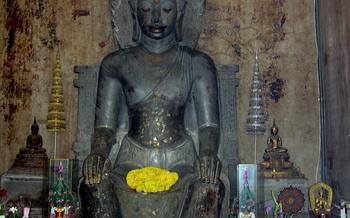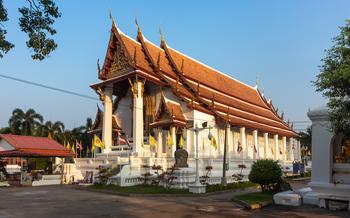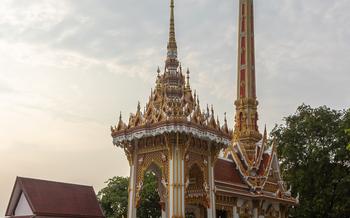
Wat Chedi Sao Lang
- Wat Chedi Sao Lang: An Ode to History and Spirituality
- Significance
- The Chedi: A Symbol of Architectural Prowess
- Exploring the Temple Grounds
- The Legend of Sao Lang
- The Importance of Chedi Sao Lang in Buddhism
- Experiencing the Local Culture
- Other Attractions in Saraburi
- The Legend of the Monkey King : Historical Context
- Restoration and Conservation Efforts
- The Role of Wat Chedi Sao Lang in the Community
- Wat Chedi Sao Lang in Popular Culture
- The Future of Wat Chedi Sao Lang
- Insider Tip: Hidden Gem
Wat Chedi Sao Lang: An Ode to History and Spirituality
Significance
A journey to Thailand, specifically to the province of Saraburi, would be incomplete without visiting the awe-inspiring Wat Chedi Sao Lang. Constructed in the 15th century, this sacred temple bears testament to the artistry and devotion of the Ayutthaya Kingdom. Its unique architectural style, profound religious significance, and rich cultural heritage make it a must-see destination for travelers seeking a glimpse into Thailand's storied past.
Architectural Style: Wat Chedi Sao Lang showcases a mesmerizing blend of Khmer and Thai architectural influences. The striking chedi, or stupa, that dominates the temple's skyline is a testament to the Khmer legacy. Adorned with intricate carvings, the chedi's design is reminiscent of the grandeur of Angkor Wat. The temple's other structures, such as the viharn (assembly hall) and the ubosot (ordination hall), exhibit a harmonious fusion of Thai and Khmer elements, creating a unique architectural masterpiece.
Religious Importance: In Thailand, Buddhism holds a central place in the cultural and spiritual landscape. Wat Chedi Sao Lang serves as a sacred site for both monks and local communities. The temple's chedi enshrines a revered Buddha relic, making it a place of pilgrimage and devotion. The temple also hosts significant religious ceremonies and festivals throughout the year, attracting thousands of faithful followers who seek blessings and spiritual fulfillment.
Cultural Heritage: Wat Chedi Sao Lang is deeply intertwined with the cultural heritage of Saraburi province. The temple has long been a center of community life, hosting traditional ceremonies, festivals, and gatherings. The temple's intricate murals, sculptures, and artifacts provide a glimpse into the province's rich history, traditions, and beliefs. Locals hold Wat Chedi Sao Lang in high esteem as a symbol of their cultural identity and a source of spiritual inspiration.
The Chedi: A Symbol of Architectural Prowess
The Chedi of Wat Chedi Sao Lang stands as a testament to the architectural prowess of the ancient Thai people. It features a unique design, characterized by its tall, slender spire that rises gracefully towards the sky. The chedi's base is adorned with intricate carvings depicting scenes from Buddhist mythology, adding a touch of sacredness to its appearance. The construction techniques employed in building the chedi are remarkable, showcasing the skill and precision of the ancient artisans. Each brick was carefully laid and mortared, creating a sturdy and durable structure that has withstood the test of time. The chedi's design symbolizes the concept of reaching enlightenment, with its spire pointing towards the heavens. The intricate details and symbolism embedded in the chedi's structure make it a masterpiece of Thai architecture and a significant landmark in Saraburi.
Exploring the Temple Grounds
Wat Chedi Sao Lang's temple grounds are a testament to its architectural prowess and religious significance. As you enter the temple complex, you'll be greeted by a serene and peaceful atmosphere, inviting you to leave behind the hustle and bustle of everyday life. The layout of the grounds is carefully designed, with the chedi as the centerpiece, surrounded by other significant structures such as the ordination hall, the prayer hall, and the monks' quarters.
Take your time to explore the grounds, admiring the intricate details of the buildings and the lush greenery that surrounds them. Notice the unique features that make this temple stand out, such as the beautiful murals that adorn the walls of the ordination hall, depicting scenes from the Buddha's life and teachings. The graceful stupas and spires that rise above the temple roofs add to the overall grandeur of the complex.
One of the highlights of the temple grounds is the large pond located in front of the chedi. This pond is a symbol of purity and tranquility, and it's a popular spot for visitors to sit and reflect. You can also take a leisurely walk around the pond, enjoying the serene atmosphere and the sound of birdsong.
The Legend of Sao Lang
The legend of Sao Lang is an folklore, Sao Lang was a young woman of great beauty and kindness. One day, she was bitten by a poisonous snake while working in the fields. As she lay dying, she made a wish that a chedi be built in her honor, so that her spirit could continue to protect the people of the village.
The legend originated sometime in the 16th century, and has been passed down through generations by word of mouth. There are several variations of the story, each with its unique elements and interpretations. In some versions, Sao Lang is depicted as a goddess or a celestial being, while in others, she is portrayed as a simple village girl.
Regardless of the variations, the legend of Sao Lang holds deep cultural significance for the people of Saraburi. It represents the enduring belief in the power of faith and devotion, and the importance of honoring the memory of those who have passed on. Local residents often visit the temple to pay their respects to Sao Lang and seek her blessings, particularly during times of difficulty or uncertainty.
The Importance of Chedi Sao Lang in Buddhism
Wat Chedi Sao Lang holds immense religious significance in Buddhism, serving as a sacred site for meditation, prayer, and pilgrimage. The chedi, with its towering presence, represents the Buddha's enlightenment and the path to Nirvana. It is believed that circumambulating the chedi while reciting mantras or prayers brings merit and spiritual purification. The temple grounds provide a serene and tranquil environment, conducive to deep contemplation and meditation. Devotees from near and far flock to Wat Chedi Sao Lang to pay homage to the Buddha, seek blessings, and find solace in the temple's sacred atmosphere.
Experiencing the Local Culture
Visiting Wat Chedi Sao Lang is not just about admiring its architectural beauty; it is also about immersing yourself in the vibrant local culture. One of the best ways to do this is to interact with the monks who reside at the temple. They are a wealth of knowledge and are always happy to share their insights on Buddhism and Thai culture. Visitors are welcome to ask questions, join in on meditation sessions, or simply observe the monks as they go about their daily lives.
The temple also hosts a number of traditional ceremonies and festivals throughout the year. These events are a great opportunity to witness the rich cultural heritage of Saraburi and to participate in the lively festivities. Visitors can enjoy traditional Thai music and dance performances, sample delicious local cuisine, and purchase unique handicrafts and souvenirs.
Other Attractions in Saraburi
While Wat Chedi Sao Lang is the main attraction in Saraburi, there are several other places that are worth exploring. The province is home to a number of other temples and historical sites, including the Wat Phra Buddha Bat, which is known for its large Buddha footprint. Nature lovers can visit the Khao Yai National Park, which is home to a variety of wildlife, including elephants, tigers, and bears. Saraburi also has a number of cultural events and activities throughout the year, such as the Saraburi Elephant Festival and the Saraburi Silk Fair. For those looking for a more local experience, the province is home to a number of traditional markets and shops where visitors can find handicrafts, souvenirs, and local delicacies.
The Legend of the Monkey King : Historical Context
The legend of the Monkey King, also known as Sun Wukong, is deeply rooted in Chinese mythology and folklore. It originated during the Ming Dynasty in the 16th century and gained popularity through the classic novel "Journey to the West" written by Wu Cheng'en. The tale narrates the adventures of the Monkey King, a mischievous and powerful deity born from a magical stone, as he accompanies the Buddhist monk Xuanzang on a perilous journey to India to retrieve sacred Buddhist scriptures.
The legend reflects the prevailing religious, cultural, and political influences of the Ming Dynasty. It draws inspiration from Buddhist teachings, Taoist beliefs, and Chinese folk traditions. The Monkey King's character embodies the essence of rebellion, transformation, and the pursuit of enlightenment. It also highlights the importance of perseverance, loyalty, and the power of compassion.
Restoration and Conservation Efforts
Wat Chedi Sao Lang has faced significant challenges in its preservation due to its age and exposure to the elements. Over the years, restoration and conservation efforts have been undertaken to ensure the longevity of this cultural treasure. These endeavors involve meticulous techniques and methods, such as structural reinforcement, stone cleaning, and restoration of intricate details.
Preserving the cultural heritage of Wat Chedi Sao Lang is of utmost importance. Through careful restoration, the temple's historical significance and architectural beauty are maintained for future generations. The preservation efforts not only protect the physical structure but also safeguard the intangible cultural values associated with the temple.
The process of restoring and conserving Wat Chedi Sao Lang involves collaboration between experts in archaeology, architecture, and cultural heritage. They meticulously assess the condition of the temple, identify areas requiring attention, and develop appropriate conservation strategies. Traditional techniques are often combined with modern technology to ensure the authenticity and integrity of the restoration work.
The successful restoration of Wat Chedi Sao Lang serves as an exemplar of how cultural heritage can be preserved while respecting its historical significance. It stands as a testament to the dedication and expertise of those committed to safeguarding Thailand's rich cultural legacy.
The Role of Wat Chedi Sao Lang in the Community
Wat Chedi Sao Lang is not just a religious and historical landmark; it also plays a vital role in the social and cultural fabric of the local community. It serves as a social and cultural center, hosting various events, gatherings, and celebrations throughout the year. The temple is a place where locals come together to share traditions, socialize, and celebrate their heritage.
The monks at Wat Chedi Sao Lang provide spiritual guidance and education to the community. They conduct regular teachings, meditation sessions, and ceremonies, fostering a sense of spirituality and well-being among the locals. The temple is also a place of learning, where people can deepen their understanding of Buddhism and its teachings.
Additionally, Wat Chedi Sao Lang is a hub for community events and gatherings. It hosts festivals, fairs, and markets, bringing people together to celebrate their culture and traditions. These events provide opportunities for locals to interact, share their experiences, and strengthen their bonds.
The temple's presence in the community also promotes a sense of unity and cooperation. It serves as a common ground where people from different backgrounds and walks of life come together to celebrate their shared heritage. Wat Chedi Sao Lang is a symbol of community spirit and cooperation, fostering a sense of belonging and togetherness among the locals.
Wat Chedi Sao Lang in Popular Culture
Wat Chedi Sao Lang has been a source of inspiration and fascination in popular culture, capturing the attention of artists, writers, and filmmakers alike. Its unique history and architectural beauty have been immortalized in literature, art, and various media, contributing to its widespread recognition and significance.
One notable depiction of the temple can be found in the novel "The Siam Diaries" by Nick Carter, which explores the adventures of a young traveler in Thailand. The novel features a vivid description of the temple, highlighting its grandeur and religious importance.
Wat Chedi Sao Lang has also made its way onto the silver screen, appearing in several Thai films and documentaries. These cinematic portrayals showcase the temple's stunning visuals and provide a glimpse into its cultural and historical significance.
Moreover, the temple's distinctive features and serene atmosphere have captivated artists, who have created paintings, sculptures, and other works of art inspired by its beauty. These artistic interpretations offer a unique perspective on the temple, capturing its essence and evoking a sense of awe and wonder.
The temple's popularity has extended beyond Thailand, attracting international attention and recognition. Its unique architecture and rich history have made it a popular destination for tourists and travelers, contributing to its status as a symbol of Thai culture and heritage.
Wat Chedi Sao Lang's presence in popular culture underscores its enduring legacy and cultural significance. By capturing the imagination of artists, writers, and filmmakers, the temple has transcended its religious and historical importance, becoming a symbol of Thailand's rich cultural heritage and a source of inspiration for generations to come.
The Future of Wat Chedi Sao Lang
Wat Chedi Sao Lang continues to stand as a testament to the ingenuity and devotion of the Thai people. As the years go by, efforts are underway to ensure its preservation and longevity. Ongoing restoration and conservation projects aim to address the challenges posed by time and the elements, employing traditional techniques and modern technology to maintain the integrity of the structure.
Plans are also in place for the development and expansion of the temple grounds. These initiatives seek to enhance the visitor experience, while respecting the sacred nature of the site. Sustainable tourism practices are being implemented to minimize the environmental impact and promote responsible tourism.
The future of Wat Chedi Sao Lang is bright, as it continues to play a vital role in the community and the nation. By preserving and promoting its cultural heritage, the temple ensures that future generations can appreciate its beauty, significance, and enduring legacy.
Insider Tip: Hidden Gem
For an unforgettable experience, venture off the beaten path to discover a hidden gem within Wat Chedi Sao Lang. Behind the main temple, nestled amidst lush greenery, lies a serene pond adorned with vibrant lotus flowers. This tranquil spot offers a breathtaking panoramic view of the temple complex, with the majestic chedi rising majestically in the background. As the sun sets, the sky transforms into a canvas of vibrant hues, casting a golden glow upon the temple and creating a truly magical atmosphere. Relax by the pond, embrace the tranquility, and soak in the beauty of this hidden gem.






